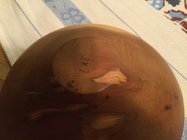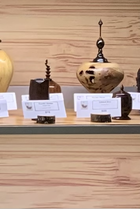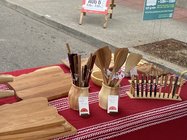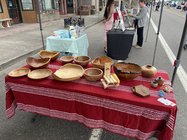I'm going to be taking part in my first outdoor crafts fair next week. (Hopefully the California drought won't decide to recede on those two days...). I was wondering how folks have handled the question of how to label pieces with prices. I have a fairly restrained presentation - spaces between pieces, black cloth covering the tables - going for a refined look. Wide range of sizes, from little mushrooms/hedgehogs to big bowls/platters. I had been thinking I would post a simple business card sized card for each item in a little stand - again thinking it would feel refined, not chintzy - but it's way too distracting and cluttered. What do you think about cards, but placed underneath the pieces? Or should I just be putting some little sticker with the price on the bottoms? If so, what works that both sticks, but doesn't leave any residue? Actual stickers, or some sort of tape? Any approach that I haven't even considered? Any experience you have to share would really be appreciated.
-
It's time to cast your vote in the December 2025 Turning Challenge. (click here for details) -
Congratulations to Pat White for "Sicilian Mosaic" being selected as Turning of the Week for December 29, 2025 (click here for details) -
Welcome new registering member. Your username must be your real First and Last name (for example: John Doe). "Screen names" and "handles" are not allowed and your registration will be deleted if you don't use your real name. Also, do not use all caps nor all lower case.
You are using an out of date browser. It may not display this or other websites correctly.
You should upgrade or use an alternative browser.
You should upgrade or use an alternative browser.
Crafts Fair Setup
- Thread starter Steven Forrest
- Start date
- Joined
- Apr 27, 2004
- Messages
- 9,308
- Likes
- 6,080
- Location
- Lakeland, Florida
- Website
- www.hockenberywoodturning.com
The little adhesive dots work well but are a little more work. Put them on before the show or as you place items out and we take them off if the piece is being stored more than a few weeks between shows. Never had an issue with residue if they came off in a few weeks. We used little signs for things like ornaments.
We did not want the customers handling the ornaments. For bowls and hollow forms handling to see the price would often sell the piece.
One nice method I liked was one I saw where the artist had small polished black rocks with nicely lettered prices painted on.
This works well if you price similar sized items the same so that you have a lot of items with the same price.
The Little Rock’s did not distract and were easy to see which piece they went with.
We did not want the customers handling the ornaments. For bowls and hollow forms handling to see the price would often sell the piece.
One nice method I liked was one I saw where the artist had small polished black rocks with nicely lettered prices painted on.
This works well if you price similar sized items the same so that you have a lot of items with the same price.
The Little Rock’s did not distract and were easy to see which piece they went with.
Last edited:
I use signs for things like tops or animal figures. For bowls I use small rectangular stickers (about 1/2 x 3/4") on the bottom of the bowls. I thought about having a card inside each bowl, but there is the issue of keeping a card with a specific bowl and I didn't want to block people seeing the bowl. Also, by having the sticker on the bottom they are encouraged to pick them up, which I think is as much part of experiencing a bowl as seeing it. Hockenbery is right about taking the stickers off if you are storing them for any length of time.
Stickers on the bottom of bowls. I use oil and wax for my finishes, so getting the stickers to stay on is more of a problem than residue.
I also got a tag shaped punch so I could print my logo on card stock then punch out tags to tie onto som items. Here is a link to the punch I use. https://amzn.to/3IfRtmW
I also used business cards held in little blocks of wood for some other items.
I also got a tag shaped punch so I could print my logo on card stock then punch out tags to tie onto som items. Here is a link to the punch I use. https://amzn.to/3IfRtmW
I also used business cards held in little blocks of wood for some other items.
Attachments
You might consider putting a name/number when you sign the piece, and then you can use a price sheet or price cards on the table.
Some also value signed/numbered pieces
Some also value signed/numbered pieces
When I did shows, I would have 3 shelves, going on 3 sides of the booth. Under the shelves were furniture pieces. I would have multiple stacks of smaller bowls and plates. I used the blue painter's tape that I cut with scissors, so the edges were neat, to mark prices on the stacks. The painter's tape doesn't leave residue on the pieces, both furniture and bowls. It also does not blow away in the wind. On some of the furniture pieces, I would use my business cards with a little roll of tape on the back side with wood ID, and dimensions on the card. On individual big pieces, some times tape on the piece, some times tape on the shelf. Only problem was people not putting things back where they found them....
robo hippy
robo hippy
You can use gaffers tape on the pieces as it does not leave any residue. I have left it on my camera tripods for more than a year at a time without any sticky residue left behind upon removal of the tape.
Tom Gall
TOTW Team
I always used the 1/4" white round label dots. Never removed them. In most cases I would remove the label when sold. If there was any residue I had a waxy cloth (paste wax) which would remove it without a problem. I always wiped off the sold piece with an old tee shirt to remove any dust or fingerprints anyway - and it was only about 2 seconds to wipe/buff the newly applied wax just applied.
Thanks so much, folks!
I found my stickers. They are Avery 5412 measuring 5/16" x 1/2"I use signs for things like tops or animal figures. For bowls I use small rectangular stickers (about 1/2 x 3/4") on the bottom of the bowls. I thought about having a card inside each bowl, but there is the issue of keeping a card with a specific bowl and I didn't want to block people seeing the bowl. Also, by having the sticker on the bottom they are encouraged to pick them up, which I think is as much part of experiencing a bowl as seeing it. Hockenbery is right about taking the stickers off if you are storing them for any length of time.
- Joined
- Jul 18, 2018
- Messages
- 1,352
- Likes
- 2,930
- Location
- Baltimore, MD
- Website
- loujacobswoodturning.com
We visited a turners shop in Kinsale on a trip to Ireland a few years ago. She did this and it was easy to pick up the price sheet and look at the work with it in hand. We bought a small yew bowl which I cherish. I’ve tried to index my turnings this way, but found it challenging to keep updating the list and removing sold item numbers from the list. Now I just use adhesive dots, about 5/8” diameter.You might consider putting a name/number when you sign the piece, and then you can use a price sheet or price cards on the table.

Hey Steve,
Good luck at the sale.
I have tried the sticker thing. They work fine, until you try and take them off. Even the ones that were supposed to come off easily. The best stickers I have seen, are used by the Sebastopol Art Center.....they are printable and they come off, without leaving glue. They are made from clear plastic with glue.
One thing I have found is that if you leave a sticker on the bowl for much time.....between shows.....the glue sticks that much more. Had to repair some bowls when I did that. What I ended up doing is using tags.....you know the kind that have a hole to run string through. Except, I do not use the string ones. They are about 2" x 1"...tan in color.....have the hole for the string, but as I said, I do not use string. I just write on the tag they type of wood and the price. Drop it in the bowl. After the show is over, there is no glue or repairs to finish. Easy to change a price.....make a new tag. Bought 500 of them on Amazon.
Good luck at the sale.
I have tried the sticker thing. They work fine, until you try and take them off. Even the ones that were supposed to come off easily. The best stickers I have seen, are used by the Sebastopol Art Center.....they are printable and they come off, without leaving glue. They are made from clear plastic with glue.
One thing I have found is that if you leave a sticker on the bowl for much time.....between shows.....the glue sticks that much more. Had to repair some bowls when I did that. What I ended up doing is using tags.....you know the kind that have a hole to run string through. Except, I do not use the string ones. They are about 2" x 1"...tan in color.....have the hole for the string, but as I said, I do not use string. I just write on the tag they type of wood and the price. Drop it in the bowl. After the show is over, there is no glue or repairs to finish. Easy to change a price.....make a new tag. Bought 500 of them on Amazon.
Dave Landers
Beta Tester
One hint I heard (and have just started to try) is to stick the sticker to your finger/thumb/hand first, then put it on the bowl. Should weaken the glue just a bit.I have tried the sticker thing. They work fine, until you try and take them off. Even the ones that were supposed to come off easily.
Oh, NEVER leave a sticker on cherry. Even a business card on a sunny day will leave a sun spot....
robo hippy
robo hippy
Tom Gall
TOTW Team
Not if its on the bottom!Oh, NEVER leave a sticker on cherry. Even a business card on a sunny day will leave a sun spot....
robo hippy
We each have our preferences. I don’t like stickers because the customer must pick up and handle the piece to see the price. And yes they do fall off. He may think it is a $30 where it is a $100 piece and then you have the risk of damage because of the handling by someone who has no intention of buying . I use cards I print and put in limb cutoffs.


- Joined
- Feb 6, 2010
- Messages
- 3,464
- Likes
- 2,536
- Location
- Brandon, MS
- Website
- threeringswoodshop.square.site
3M makes a easy release tape which practically falls off with a little tug. I use round stickers on the bottom mostly.
Anyone use Post-It Notes?
- Joined
- Feb 28, 2021
- Messages
- 1,778
- Likes
- 1,592
- Location
- Roulette, PA
- Website
- www.reallyruralwoodworks.com
I have to use tags on most of my stuff - my finishes are too smooth and since I use Tried & True finishes mostly, nothing (not even super glue) sticks to the item anyways. I may try a crayon or dry erase marker as an experiment , but the trouble with that , it puts the buyers off if they don't realize it'll easily rub off. I may instead start marking tiny item ID numbers on signed pieces (signed and numbered limited edition is always a selling point) that I can't readily apply a tag to..
Brian, that is why I some times would put the tags on the shelf, and in large print. I still would get a lot of people who would pick up a piece, and the price was clearly visible, with a $ on it, and they would ask me how much it costs.....
robo hippy
robo hippy
I cut little angled blocks of wood to stick on a paper dot, and place it right next to the object. I keep numbers small on purpose. If they can read the price while walking, they will keep walking. I also make sure to have some vibrant dyed vessels or bowls up front. A table full of round and brown is quite a turn off. I use color to draw them in. Lastly I make little pedestals from 8/4 stock or thicker to elevate some of the pieces. A flat table filled with round and brown speaks of garage sale to me.


